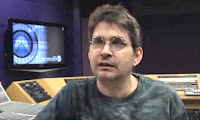Winter NAMM has come and gone once again, and left us with a lot to talk about. Once again there was nothing so new and revolutionary that everyone at the show was talking about (as expected), but there were some cool new things that were shown, as well as some disappointments, and some that were downright absurd.
Here are a few things that jumped out at me during my walk around NAMM. I covered it from a slightly different angle and more in depth on
my Inner Circle podcast.
 Shure KSM8 Dualdyne
Shure KSM8 Dualdyne - This is a dual diaphragm condenser mic that reportedly gets rid of the 3.5kHz bump and the proximity response. The problem is that after 50 years of SM58s, I think we all like that sound. It
's expensive at $499.
 Manley Nu Mu
Manley Nu Mu - Here's a less expensive alternative to Manley's famous
VariMu compressor with a new HIP control that allows lots of compression without losing any detail. Around $2,300 on the street.
 Mackie AXIS
Mackie AXIS - This is a remote controllable mixer with remote preamps that's intended for installed sound systems. It can use up to 3
iPads as displays. Available in 16 and 32 input versions. No word on prices yet.
 Dave Smith OB6
Dave Smith OB6 - One of the sounds of the 80s is the
Oberheim OB6 synthesizer and now
Dave Smith Instruments has brought the unit back in collaboration with
Tom Oberheim. Complete with effects and a sequencer, it sells for around $3k
 Slate Raven MTi2
Slate Raven MTi2 - I think I'm softening on my position to touchscreen controllers after playing with the new Raven MTi2. All of the most used parameters are at the bottom of the screen so you don't have to lift your arm that much. Plus, there are a ton of useful add-ons that will work with any DAW. A bargain for a 27" touchscreen monitor/controller at $1k
 Solomon LoFreQ
Solomon LoFreQ - Many engineers won't record a drum kit without using a subkick mic, but up until now the commercial ones have used 8 inch drivers instead of the 6 1/2" NS10 driver that we all grew to love. The LowFreQ uses that same diameter driver, and compensates for the level differences between subkick and regular kick mic as well.
Priced very reasonably at $199.
 Subwoofer Pros
Subwoofer Pros - There hasn't been a company since
M&K that specialized in subwoofers, but that's exactly what
Brad Lunde's new Subwoofer Pros does. The cabinets are not ported so there's a smoother frequency response, they have a lot of power, and a built-in crossover and bass management. Two models available, either a 12" or 18" starting at around $2k
 GTC Revpad
GTC Revpad - This is one of the coolest things I saw at the show. It's a wireless touchpad that velcros to a guitar's pickguard. From there you can wirelessly control and crossfade between a variety of onboard or external effects with the greatest of ease. Around $1200.
 Fostex Headphones
Fostex Headphones - I love Fostex headphones and have used T20s in various versions for more than 20 years. Now the T models are back in circulation.
From about $120.
Part 2 tomorrow.
 It's always fun to listen to what's inside a hit record, especially when some of the polish is wiped off. Here's a great example of a great arrangement and playing on The Temptations big hit "Papa Was A Rolling Stone." It's the instrumental-only version, except for the background harmony vocals in the chorus. Here's what to listen for.
It's always fun to listen to what's inside a hit record, especially when some of the polish is wiped off. Here's a great example of a great arrangement and playing on The Temptations big hit "Papa Was A Rolling Stone." It's the instrumental-only version, except for the background harmony vocals in the chorus. Here's what to listen for.






















